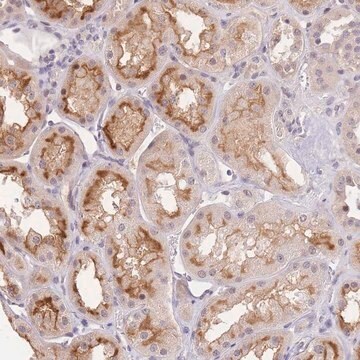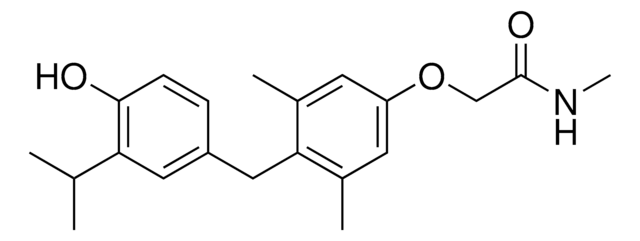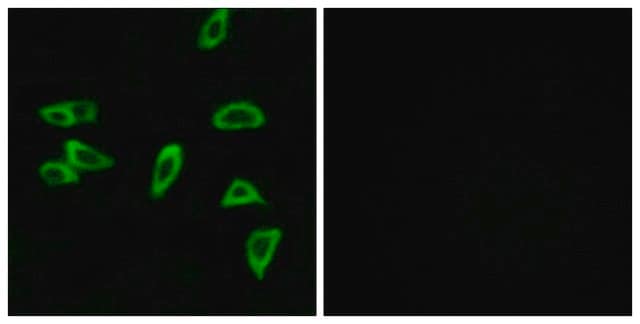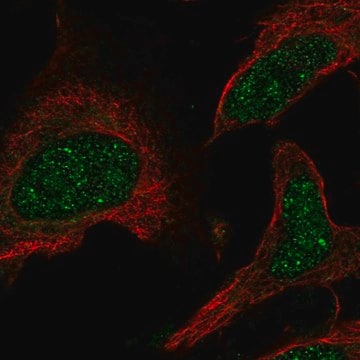OGS614
PSF-PA-PROMMCS-KRYFP - PROMOTERLESS MULTIPLE CLONING SITE YFP PLASMID
plasmid vector for molecular cloning
Synonym(s):
cloning vector, expression vector, molecular cloning vector, plasmid, plasmid vector, snapfast vector, vector
Sign Into View Organizational & Contract Pricing
All Photos(2)
About This Item
UNSPSC Code:
12352200
Recommended Products
form
buffered aqueous solution
mol wt
size 4613 bp
bacteria selection
kanamycin
Origin of replication
pUC (500 copies)
Peptide cleavage
no cleavage
reporter gene
none
shipped in
ambient
storage temp.
−20°C
General description
Kringle YFP (Yellow Fluorescence Protein) expression vector with a multiple cloning site upstream to allow your preferred promoter to be inserted. Also contains a poly A site upstream to reduce background readthrough in mammalian systems
Application
Cloning in a gene: PSF-PA-PROMMCS-KRYFP - PROMOTERLESS MULTIPLE CLONING SITE YFP PLASMID contains a gene within the main multiple cloning site (NotI-ClaI). Any plasmid that we sell where the gene is this configuration will be located in the exact same position in relation to the start and stop codon of the gene. The only exceptions to this rule are fusions proteins where the fusion gene may be positioned at the front or end of the MCS to allow gene fusion.
By positioning all of our genes in the same location it allows them to be transferred between plasmids using the same cloning method and restriction sites regardless of the plasmid being used from our product range. Inserting a new gene into this plasmid should be easily possible using a range of standard restriction enzyme sites that flank the gene currently in the vector.
Multiple cloning site notes: In the multiple cloning site there are two important restriction sites called BsgI and BseRI sites. These sites both cut the DNA at the same position and cleave the stop codon of the gene in the multiple cloning site in this plasmid thereby producing a TA overhang. This overhang is compatible with any of our peptide or reporter fusion tag plasmids also cut with either of these enzymes. This allows seamless C-terminal fusions to be made with the gene in this multiple cloning site using a single cloning step from our C-terminal peptide and reporter tag product range. Normally the easiest method is to clone the C-terminal tag from our other plasmid products into this plasmid using BsgI or BseRI and the downstream ClaI restriction site.
BseRI and BsgI sites are non-palindromic and cleave a defined number of bases away from their binding sites. This allows them to cut the upstream stop codon in the gene in this plasmid regardless of the gene sequence.
By positioning all of our genes in the same location it allows them to be transferred between plasmids using the same cloning method and restriction sites regardless of the plasmid being used from our product range. Inserting a new gene into this plasmid should be easily possible using a range of standard restriction enzyme sites that flank the gene currently in the vector.
Multiple cloning site notes: In the multiple cloning site there are two important restriction sites called BsgI and BseRI sites. These sites both cut the DNA at the same position and cleave the stop codon of the gene in the multiple cloning site in this plasmid thereby producing a TA overhang. This overhang is compatible with any of our peptide or reporter fusion tag plasmids also cut with either of these enzymes. This allows seamless C-terminal fusions to be made with the gene in this multiple cloning site using a single cloning step from our C-terminal peptide and reporter tag product range. Normally the easiest method is to clone the C-terminal tag from our other plasmid products into this plasmid using BsgI or BseRI and the downstream ClaI restriction site.
BseRI and BsgI sites are non-palindromic and cleave a defined number of bases away from their binding sites. This allows them to cut the upstream stop codon in the gene in this plasmid regardless of the gene sequence.
Analysis Note
To view the Certificate of Analysis for this product, please visit www.oxgene.com
Other Notes
OXGENE′s technology platforms and expert solutions accelerate the discovery, development and manufacture of cell and gene therapies. We work with you to express your gene of interest at scale, with high levels of purity. In addition, our integrated bioinformatics and high-throughput gene editing technology creates a streamlined workflow for automated cell line production. learn more at www.oxgene.com
related product
Product No.
Description
Pricing
Storage Class Code
12 - Non Combustible Liquids
Flash Point(F)
Not applicable
Flash Point(C)
Not applicable
Certificates of Analysis (COA)
Search for Certificates of Analysis (COA) by entering the products Lot/Batch Number. Lot and Batch Numbers can be found on a product’s label following the words ‘Lot’ or ‘Batch’.
Already Own This Product?
Find documentation for the products that you have recently purchased in the Document Library.
Alexander C Cerny et al.
PLoS genetics, 11(10), e1005578-e1005578 (2015-10-29)
Recycling of signaling proteins is a common phenomenon in diverse signaling pathways. In photoreceptors of Drosophila, light absorption by rhodopsin triggers a phospholipase Cβ-mediated opening of the ion channels transient receptor potential (TRP) and TRP-like (TRPL) and generates the visual
Geoffrey M Lynn et al.
Nature biotechnology, 33(11), 1201-1210 (2015-10-27)
The efficacy of vaccine adjuvants such as Toll-like receptor agonists (TLRa) can be improved through formulation and delivery approaches. Here, we attached small molecule TLR-7/8a to polymer scaffolds (polymer-TLR-7/8a) and evaluated how different physicochemical properties of the TLR-7/8a and polymer
Diana Romero et al.
Carcinogenesis, 37(1), 18-29 (2015-10-28)
Dickkopf-3 (Dkk-3) is a secreted protein whose expression is downregulated in many types of cancer. Endogenous Dkk-3 is required for formation of acini in 3D cultures of prostate epithelial cells, where it inhibits transforming growth factor (TGF)-β/Smad signaling. Here, we
Jin-Gyoung Jung et al.
PLoS genetics, 10(10), e1004751-e1004751 (2014-10-31)
The Notch3 signaling pathway is thought to play a critical role in cancer development, as evidenced by the Notch3 amplification and rearrangement observed in human cancers. However, the molecular mechanism by which Notch3 signaling contributes to tumorigenesis is largely unknown.
Our team of scientists has experience in all areas of research including Life Science, Material Science, Chemical Synthesis, Chromatography, Analytical and many others.
Contact Technical Service






